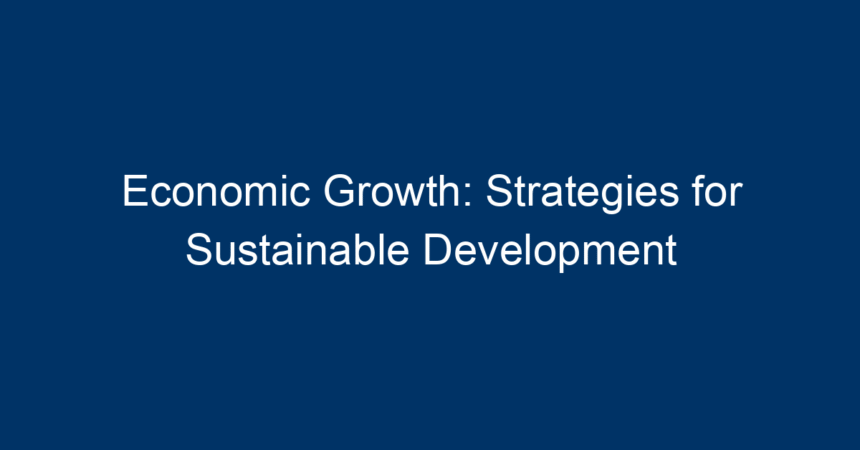Introduction
Economic growth is a fundamental pursuit for nations worldwide, often measured by the increase in a country’s GDP (Gross Domestic Product). Yet, the challenge lies not only in boosting numbers but doing so sustainably. As we face pressing global issues such as climate change, resource depletion, and social inequality, it is essential to develop strategies that promote economic growth while enhancing environmental stewardship and social equity. This article explores effective strategies for achieving economic growth through sustainable development, ensuring a thriving economy for future generations.
Understanding Economic Growth
Economic growth represents a country’s ability to produce more goods and services over a specific period. It’s a crucial indicator of a nation’s health and prosperity. Traditionally, economic growth has relied on increased consumption and resource exploitation. However, this traditional approach is increasingly scrutinized, leading to the need for sustainable practices that prioritize ecological balance and social well-being.
The Importance of Sustainable Economic Growth
Sustainable economic growth is not just a buzzword; it is a necessity. The World Bank defines sustainable development as meeting the needs of the present without compromising the ability of future generations to meet their own needs. By integrating sustainability into economic growth strategies, nations can address crucial issues such as poverty alleviation, social inclusion, and the preservation of natural resources.
Key Strategies for Sustainable Economic Growth
1. Promoting Green Technologies
One of the most effective strategies for achieving economic growth sustainably is investing in green technologies. The adoption of renewable energy sources, such as solar, wind, and hydroelectric power, reduces reliance on fossil fuels and decreases greenhouse gas emissions.
Benefits of Green Technologies:
- Job Creation: The green sector is labor-intensive, creating numerous employment opportunities.
- Long-Term Cost Savings: Finally transitioning to renewable energy can lead to significant long-term savings, helping both businesses and consumers.
2. Enhancing Education and Skills Development
Investing in education and skills development is crucial for fostering economic growth. An educated workforce is better equipped to adapt to new technologies, innovate, and drive productivity.
Educational Strategies:
- Vocational Training: Initiatives that align skills training with local industry needs can lead to immediate job placements.
- STEM Focus: Emphasizing Science, Technology, Engineering, and Mathematics in education encourages future innovation and competitiveness.
3. Encouraging Sustainable Urban Development
Urbanization presents significant challenges for economic growth. Sustainable urban development focuses on creating cities that are not only economically vibrant but also environmentally responsible.
Key Approaches:
- Smart Cities: Utilizing technology to enhance urban living through efficient resource management, improved public transportation, and reduced carbon footprints.
- Green Spaces: Incorporating parks and recreational areas within urban settings contributes to public health and environmental sustainability.
4. Fostering Social Equity
An equitable society is integral to sustained economic growth. Addressing inequalities can increase social cohesion and empower marginalized communities.
Strategies for Social Equity:
- Inclusive Policies: Implementing policies that support minority-owned businesses can stimulate local economies.
- Minimum Wage Increases: Raising wages can boost consumer spending, driving economic growth.
5. Promoting Sustainable Agriculture
The agriculture sector is vital for economic growth and food security. Sustainable farming practices can enhance productivity while protecting the environment.
Sustainable Agricultural Practices:
- Organic Farming: The demand for organic products is rising, offering economic opportunity while fostering biodiversity.
- Agroforestry: Combining trees and crops promotes soil health and resiliency, which can lead to increased yields.
6. Investing in Infrastructure
Strong infrastructure is the backbone of a flourishing economy. Sustainable infrastructure investments can enhance productivity while minimizing environmental impact.
Infrastructure Strategies:
- Public Transport Investments: Developing efficient and sustainable public transport systems reduces congestion and pollution.
- Green Buildings: Encouraging the construction of energy-efficient buildings contributes to resource conservation and economic savings.
Case Studies in Sustainable Economic Growth
1. Denmark’s Renewable Energy Revolution
Denmark has emerged as a global leader in renewable energy, primarily through its robust wind power sector. The country now generates over 40% of its energy from wind, illustrating that ambitious commitments to green technologies can spur economic growth while drastically reducing carbon emissions.
2. Bhutan’s Gross National Happiness Index
Bhutan measures its success with a focus on Gross National Happiness rather than traditional economic growth metrics. This holistic approach prioritizes well-being, cultural integrity, and environmental sustainability, providing insights into how diverse indicators can define economic success.
Challenges to Sustainable Economic Growth
While opportunities abound, there are significant challenges to achieving sustainable economic growth:
- Resource Limitations: The availability of natural resources can impact growth strategies.
- Political Will: Strong leadership and commitment are required to implement sustainable policies effectively.
- Globalization: As economies become increasingly interdependent, balancing local needs with global pressures becomes complex.
Actionable Insights for Policymakers, Businesses, and Individuals
For Policymakers:
- Develop Comprehensive Sustainability Strategies: Collaborate with stakeholders to create frameworks that prioritize sustainable economic growth.
- Allocate Resources for Education: Invest in education systems that foster skills relevant to the future job market.
For Businesses:
- Adopt Sustainable Practices: Embrace CSR (Corporate Social Responsibility) initiatives that focus on environmental and social governance.
- Engage in Innovation: Foster a culture of innovation that focuses on sustainability.
For Individuals:
- Support Sustainable Businesses: Make purchasing decisions that align with sustainability principles.
- Advocate for Change: Get involved in community initiatives aimed at promoting sustainability.
Conclusion
Economic growth remains a vital goal for nations worldwide, but it must evolve to reflect our modern challenges. Strategies for sustainable development are not merely options; they are essential for ensuring that future generations can thrive in a healthy, equitable, and prosperous world. By investing in green technologies, enhancing education, promoting social equity, and developing sustainable infrastructure, we can work together to create a more sustainable economic future. Ultimately, embracing these strategies will not only foster economic growth but also ensure that this growth is firmly grounded in principles of sustainability and social responsibility.
Investing in sustainable practices today is an investment in a thriving tomorrow. Each action taken today will echo through generations, fostering a world where economic growth harmonizes with the environment and society.




